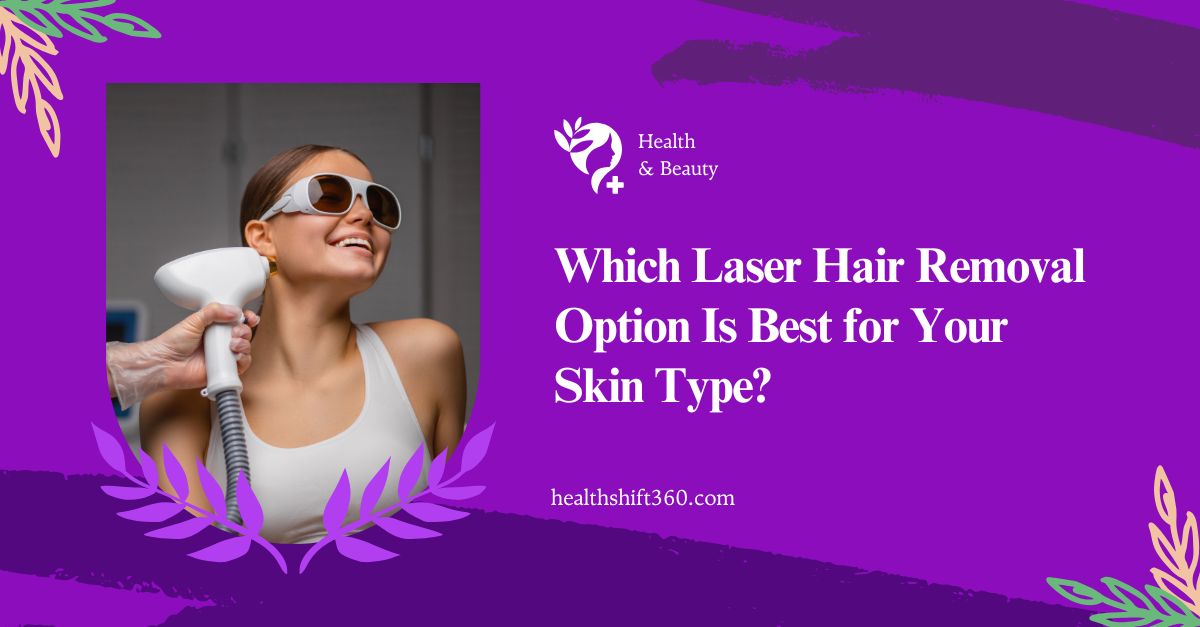Have you ever felt like there were too many choices when it came to laser hair removal? If you’re exploring permanent hair removal solutions that are truly suited for your skin tone and type, you’re not alone.
Many of us want a safe, effective treatment that understands our unique needs. Whether you’ve been researching online or heard stories from friends, it’s important to know that there are laser options designed specifically with your skin in mind.
In this guide, we’ll walk you through everything from understanding the Fitzpatrick skin type classification to comparing Diode, Nd:YAG, and Alexandrite lasers. Think of it as choosing the right pair of shoes – just as every foot is different, every skin type deserves its perfect laser match.
Why Skin Type Matters in Laser Hair Removal Treatments
Before we get into the specifics of laser treatments, it’s important to understand your skin type. Did you know dermatologists often use the Fitzpatrick Skin Type Classification to categorize skin by its reaction to sun exposure? This system ranges from Type I (very fair skin that burns easily) to Type VI (deeply pigmented dark skin that rarely burns).
Knowing your skin type helps professionals determine the safest and most effective laser hair removal treatment. For example, if you have darker skin, you might worry about potential complications or laser hair removal side effects.
However, advancements in technology mean there are now options designed to minimize risks and maximize results. With the right treatment, you can enjoy smoother skin without the worry of burns or pigmentation issues.
This understanding is the foundation of our discussion on laser hair removal for different skin types. It ensures that whether you’re considering the science behind hair removal techniques or diode vs. Nd:YAG vs. Alexandrite lasers, you’re making an informed decision that aligns with your personal skin needs.
The Science Behind Hair Removal Techniques
Laser hair removal relies on selective photothermolysis, where specific light wavelengths target melanin in hair follicles, converting it into heat to disable growth without harming surrounding skin.
The effectiveness depends on hair and skin contrast—dark hair on light skin responds best, while darker skin requires advanced lasers like Diode, Nd:YAG, and Alexandrite to ensure safety.
Understanding these technologies helps select the right treatment and minimise side effects, making professional laser hair removal more effective than at-home hair removal methods.

Overview of Laser Technologies
When considering laser hair removal, three main technologies dominate the market: Diode, Nd:YAG, and Alexandrite lasers. Each has its unique features, benefits, and challenges, especially when we compare Diode vs. Nd:YAG vs. Alexandrite lasers.
Diode Laser
Diode lasers are known for their precision and are highly effective for a range of skin types, particularly for individuals with lighter to medium skin tones.
They work by emitting a wavelength that is well absorbed by melanin, targeting hair follicles with minimal impact on surrounding tissues. This laser is often favored for its balance between effectiveness and safety, with fewer side effects when performed by experienced technicians.
Nd:YAG Laser
The Nd:YAG laser is celebrated for its safety on darker skin tones. It operates at a longer wavelength, which penetrates deeper into the skin, reducing the risk of skin damage, making it a preferred option for those with dark skin. However, while it is safe, some patients may find it less effective on lighter hair due to the lower melanin absorption at this wavelength.
Alexandrite Laser
Alexandrite lasers are known for their speed and efficiency, often delivering faster results. They are ideal for lighter skin types because dark hair absorbs the wavelength very well.
However, when used on darker skin, there can be a higher risk of complications such as burns or pigment changes, if not properly managed. This laser’s effectiveness makes it popular in clinics that cater to a wide range of hair removal needs.
These factors are critical when discussing laser hair removal for different skin types and assessing the cost of laser hair removal treatments. Additionally, professionals often compare Diode vs. Nd:YAG vs. Alexandrite lasers to determine the best match for their client’s skin tone and hair characteristics.
Comparative Analysis of Laser Options
When comparing these laser options, several factors come into play: effectiveness, safety, potential side effects, and overall suitability for various skin types. Below is a quick comparison table summarizing these factors:
| Laser Type | Effectiveness | Cost Level | Pain Level | Recommended Skin Types |
| Diode Laser | High for lighter/medium | Moderate | Mild to Moderate | Fair to medium skin; caution on dark skin |
| Nd:YAG Laser | Moderate to high | Moderate to high | Mild | Best for dark skin; safe for deeper skin layers |
| Alexandrite | Very high (rapid results) | Moderate | Moderate to high | Ideal for light skin; higher risk for dark skin |
This table helps you see the overall picture when considering laser hair removal for different skin types. While the diode laser offers excellent results for those with fairer skin, the Nd:YAG laser is often the safest bet for darker skin tones. The Alexandrite Laser, though efficient, may not be the best choice for everyone due to its increased risk profile on darker skin.
Moreover, the cost of laser hair removal treatments can vary. Factors like session length, number of sessions, and clinic reputation all contribute to the overall expense. It’s essential to consult with a dermatologist or laser technician to understand the specific pricing and potential side effects for your skin type.
By comparing the diode vs. Nd:YAG vs. Alexandrite lasers, you can better understand which treatment might provide the best balance of effectiveness and safety, especially if you’re looking for the best laser hair removal for dark skin or seeking minimal side effects.

Cost of Laser Hair Removal Treatments
Cost is often a deciding factor when choosing a laser treatment. The cost of laser hair removal treatments depends on various aspects, including the technology used, the area being treated, and the number of sessions required. On average, treatments with a diode or Alexandrite laser might be moderately priced, while the Nd:YAG Laser could be slightly higher due to its specialized use for darker skin tones.
Here are some factors that influence cost:
- Clinic Reputation: Established clinics with experienced practitioners may charge more.
- Geographic Location: Prices can vary widely depending on where you live.
- Treatment Area: Larger body areas require more time and energy, increasing the price.
- Number of Sessions: Most individuals require multiple sessions for lasting results, so the overall cost can add up.
While cost is a critical factor, it’s important to balance expense with safety and effectiveness. Remember, investing in a quality treatment with a reputable provider can reduce the risk of laser hair removal side effects and yield better long-term results.
Comparing the best at-home hair removal methods vs. professional treatments often reveals that professional clinics, though more expensive, offer tailored solutions that minimize risks.
How to Choose the Right Option for You
Choosing the right laser hair removal treatment is a personal decision. Start by understanding your skin type through the Fitzpatrick Skin Type Classification and then discuss your history with a professional. Ask questions like, “Which laser is best for dark skin tones?” or “How many sessions will I need?”
Here are some guidelines:
- Consultation: A consultation with a dermatologist can help determine which laser suits you best, especially when weighing Diode vs. Nd:YAG vs. Alexandrite lasers.
- Review Side Effects: Learn about potential laser hair removal side effects and ask for before-and-after photos.
- Consider Costs: Factor in the cost of laser hair removal treatments and decide on a budget that suits your needs.
- Preparation: Make sure you follow how to prepare for a laser hair removal session by avoiding sun exposure and following any pre-treatment instructions.
- Aftercare: Choose a clinic that offers comprehensive post-treatment care and skincare tips for sensitive skin to manage any irritation.
Post-Treatment Care & Skincare Tips for Sensitive Skin
After your treatment, proper aftercare is crucial for maintaining your results and preventing side effects. Post-treatment, your skin might feel a bit tender or look slightly red. Following these skincare tips for sensitive skin can help ease discomfort and speed up recovery:
- Cool Compress: Use a cool compress to reduce redness.
- Moisturize: Apply a gentle, fragrance-free moisturizer to soothe the skin.
- Sun Protection: Always wear sunscreen to protect treated areas.
- Avoid Harsh Products: Steer clear of exfoliants or strong skincare products until your skin has fully recovered.
- Follow-Up: Stick to any follow-up appointments to monitor progress and address any concerns.
These steps not only help to reduce laser hair removal side effects, but they also help to maintain long-term skin health. When you take care of your skin properly after a treatment, the effects will last and be smooth. Your skin will also be safe and relaxed.
Final Thoughts
Choosing the right laser hair removal option depends heavily on understanding your skin type and the nuances of each technology.
Whether you’re considering the powerful precision of the Diode Laser, the safety of the Nd:YAG Laser for dark skin, or the efficiency of the Alexandrite Laser, there’s a solution tailored for you. With the right preparation, expert consultation, and diligent aftercare, you can achieve smooth, lasting results that suit your unique needs.
Remember, this journey is personal; like choosing the perfect recipe for your favorite dish, every ingredient matters. Take your time, ask questions, and make the choice that best fits your skin’s story.



